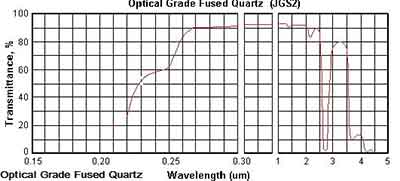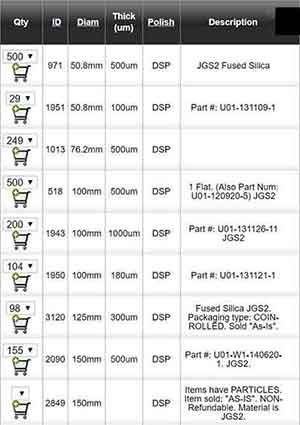I use silicon wafers and fused silica wafers as substrates for the evaluation of thin films grown on top either by ALD or CVD.
What is Fused Silica?
Fused silica is the glassy form of quartz and is thus isotropic. It is tough and hard and has a very low expansion. Normal varieties contain water which gives strong absortion in the IR. Water-free varieties are available. There are different types Fused Silica used for different application. We mainly have three types, including JGS1, JGS2, JGS3.
Get Your Fused Silica Quote FAST! Or, buy online and start researching today!
Which keyword below did you use to find use? Let us know and receive a discount on your order!
- sio2 quartz
- fused quartz windows
- fused quartz
- fused silica density
- fused quartz plate
- corning fused silica wafers
- fused silica transmission
- fused quartz density
- fused silica thermal conductivity
- fused silica windows
- fused quartz properties
- fused quartz refractive index
- fused silica refractive index
- fused quartz discs
- fused silica wafer
- buy fused silica wafers
- fused silica wafer price
- hoya fused silica wafers
- 100 mm fused silica wafers
Fused Silica Wafer Inventory
Below are just a small expample of the Fused Silica wafers that we have in stock. We can also custom make any spec!
What Fused Silica Substrate Is Used to Grow Thin Films?
A principal scientist requested our quote for the following:
UniversityWafer Replied:
The typical material is Fused SIlica JGS1 and the max diameter is max. diameter 200 mm and max. height 100 mm.
And nano grade polished finished. maybe a diameter of 150mm*6mm will be the best option based on our experience.
So, we'll issue you a best price depending on your final specs and q'ty requirement.
Reference #38321 for specs/pricing.
Optical Grade Fused Quartz
See below for the application and their equivalent to other Fused Silica supplier and our prices our usually much lower.

JGS1 Fused Silica Definition
Is transparent in the ultraviolet and visible regions. It has no
absorption hands in 170-250 nm wavelength intervals and has intensive
OH absorption band in the interval of wavelength 2600-2800 nm.
JGS1 is used for
- optics operating in the deep UV and the visible wavelength range
- Laser
- Lenses
- Windows
- Prisms
- Mirrors, etc.).
It is practically free of bubbles and inclusions.
JGS1 Fused Silica is similiar to the following Manufacturers
Heraeus - Suprasil 1 and 2 Saint-Gobain - Spectrosil A and B Coming's 7940 Dynasil's 1100 and 4100
JGS2 Fused Silica Definition
The benefits include good UV and visible transmission similiar to JGS1. Can
be made in small diameters/dimensions that can be very thin and is free
of bubbles. Cons include possible bubbles in larger dimensions/diameters.
JGS2 Fused Silica is similiar to the following Manufacturers
Heraeus' Homosil 1,2 & 3
Dynasil 1000 & 4000 & 5000 & 6000
Applications for JGS2 include:
- condenser optics
- high temperature and pressure devices
- optical flats
- microscope slides
- sight glasses

JGS3 Fused Silica Definition
JGS3 is transparent in the ultraviolet, visible and infrared spectral regions. It's absorption bands are in the 185-250 nm spectral region, but has no absorption bands in the visible physical properies with outstanding optical characteristics in the deep UV and the IR wavelength range. It is those requiring very wide wavelength range from DUV to MIR. It is quite a bit more expensive than Silicon and slightly less expensive than Calcium Fluoride or ZnS Multi-spectral grade.
JGS3: is similiar to the following manufacturers
Heraeus Suprasil 300.
What is the Refractive Index of Fused Silica Wafers?
The refractive index of a material is a measurement of how easily light will be bent or diverged by it. For quartz, thisvalue is 1.458. This value depends on the temperature and pressure of the material and the wavelength of light. Unlike other materials, quartz does not have a unit of measurement. Quartz has modest birefringent properties, but is a valuable stone in jewelry and scientific experiments.
Commercial quartz glass contains silicon and oxygen, but is also often impurities such as titanium and aluminium. These impurities limit the optical transmission of quartz in the ultraviolet. Further, water used during the manufacturing process can embed hydroxyl groups, reducing the transmission in the infrared. The transparency of quartz is so broad that it is an important starting material for optical fibers used in telecommunications.
Many experiments involving optical characterisation require a substrate, and quartz is a common choice. Quartz is low in absorption at terahertz frequencies, and has high transmission. Time-domain terahertz spectroscopy and optical pump-probe spectroscopy both require high-refractive-index materials. Quartz's refractory index is 1.463. If the refractive index is lower than that, it is referred to as "fused quartz."
A measurement of quartz's refractive index is critical to optical applications. These materials must be made using a method of production that is radially symmetric and polarization-free. These processes will produce optical quartz glass with high homogeneities. If the quartz glass is manufactured by means of a radially symmetric process, the entire process will be radially symmetric. It is important to note that the refractive index of quartz is closely related to its polarization properties.
Refractive Index (nd) at 588nm |
1.4586 | ||
| Wavelength (um) | Refractive Index (n) | Wavelength (um) | Refractive Index (n) |
| 0.200 | 1.55051 | 1.000 | 1.45042 |
| 0.220 | 1.52845 | 1.064 | 1.44962 |
| 0.250 | 1.50745 | 1.100 | 1.44920 |
| 0.300 | 1.48779 | 1.200 | 1.44805 |
| 0.320 | 1.48274 | 1.300 | 1.44692 |
| 0.360 | 1.47529 | 1.500 | 1.44462 |
| 0.400 | 1.47012 | 1.600 | 1.44342 |
| 0.450 | 1.46557 | 1.700 | 1.44217 |
| 0.488 | 1.46302 | 1.800 | 1.44087 |
| 0.500 | 1.46233 | 1.900 | 1.43951 |
| 0.550 | 1.46008 | 2.000 | 1.43809 |
| 0.588 | 1.45860 | 2.200 | 1.43501 |
| 0.600 | 1.45804 | 2.400 | 1.43163 |
| 0.633 | 1.45702 | 2.600 | 1.42789 |
| 0.650 | 1.45653 | 2.800 | 1.42377 |
| 0.700 | 1.45529 | 3.000 | 1.41925 |
| 0.750 | 1.45424 | 3.200 | 1.41427 |
| 0.800 | 1.45332 | 3.370 | 1.40990 |

